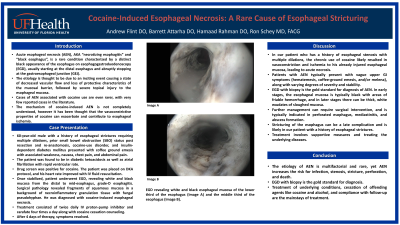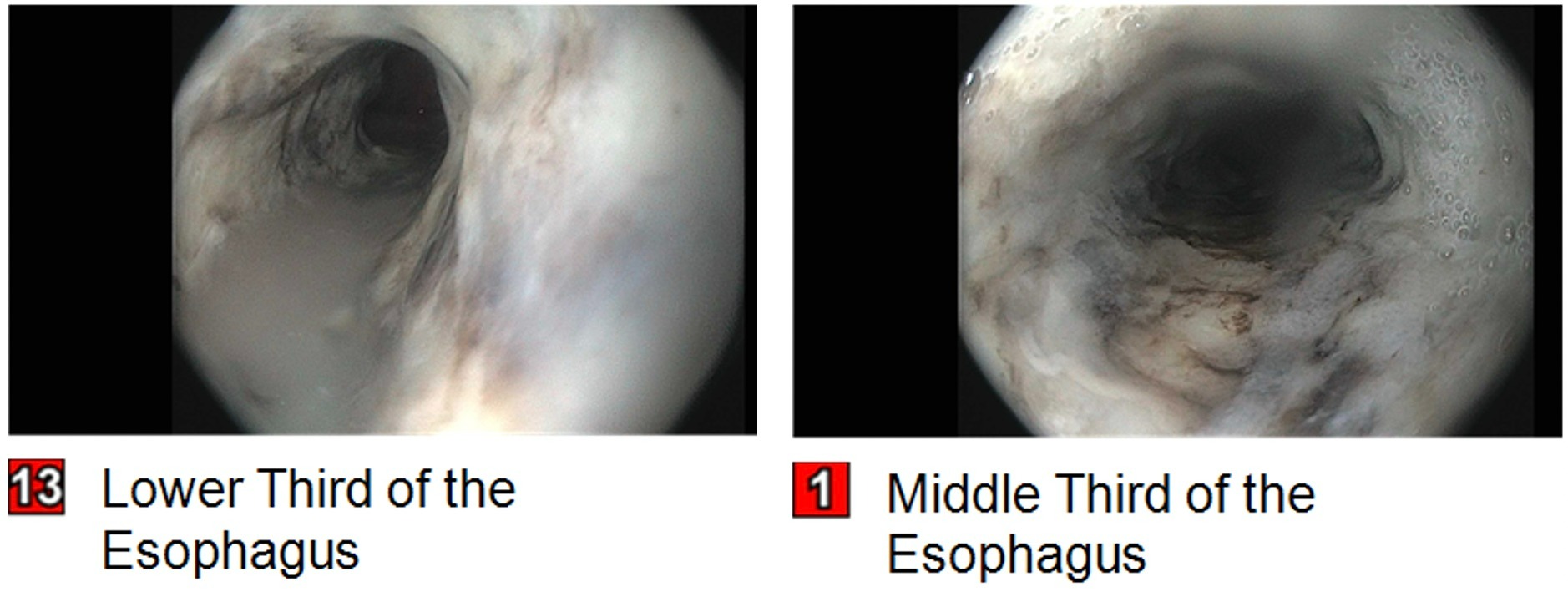Back


Poster Session A - Sunday Afternoon
Category: Esophagus
A0240 - Cocaine-Induced Esophageal Necrosis: A Rare Cause of Esophageal Stricturing
Sunday, October 23, 2022
5:00 PM – 7:00 PM ET
Location: Crown Ballroom

Has Audio

Andrew Flint, DO
UF Health Jacksonville
Jacksonville, FL
Presenting Author(s)
Andrew Flint, DO1, Barrett O. Attarha, DO2, Syed Hamaad Rahman, DO3, Ron Schey, MD1
1UF Health Jacksonville, Jacksonville, FL; 2University of Florida College of Medicine, Jacksonville, FL; 3Methodist Dallas Medical Center, Dallas, TX
Introduction: Acute esophageal necrosis (AEN) is a rare condition characterized by a distinct black appearance of the esophagus on esophagogastroduodenoscopy (EGD), usually starting at the distal esophagus and abruptly stopping at the gastroesophageal junction (GEJ). Since patients with AEN typically present with vague upper gastrointestinal symptoms, AEN is not initially high on the list of differentials.
Case Description/Methods: We present a case of a 60-year-old male with coffee ground emesis and abdominal pain. His history is significant for multiple esophageal strictures requiring numerous dilations. The patient complains of associated severe and worsening dysphagia over the last 9 months as well. On this presentation, the patient was found to be in diabetic ketoacidosis and atrial fibrillation with rapid ventricular rate. Laboratory investigations were significant for leukocytosis and an acute kidney injury. Drug screen was positive for cocaine. CT abdomen and pelvis revealed severe gastroparesis but no other acute findings. A workup for infectious etiology and other causes was negative. Two days later once stabilized, the patient underwent EGD with biopsy which revealed white and black mucosa from the distal to mid-esophagus, grade-D esophagitis. The patient was diagnosed with cocaine-induced esophageal necrosis and managed symptomatically along with instruction to cease cocaine use.
Discussion: Cases of AEN associated with cocaine use are quite rare, with only 5 reported cases in the literature. The mechanism of cocaine-induced AEN is not completely understood, however it has been thought that the vasoconstrictive properties of cocaine can exacerbate and contribute to esophageal ischemia. EGD with biopsy is the gold standard for diagnosis of AEN. Treatment of underlying conditions, cessation of offending agents like cocaine, and compliance with follow-up are the mainstays of treatment. This case is significant as it highlights not only an uncommon cause of ischemia but of esophageal stricturing.

Disclosures:
Andrew Flint, DO1, Barrett O. Attarha, DO2, Syed Hamaad Rahman, DO3, Ron Schey, MD1. A0240 - Cocaine-Induced Esophageal Necrosis: A Rare Cause of Esophageal Stricturing, ACG 2022 Annual Scientific Meeting Abstracts. Charlotte, NC: American College of Gastroenterology.
1UF Health Jacksonville, Jacksonville, FL; 2University of Florida College of Medicine, Jacksonville, FL; 3Methodist Dallas Medical Center, Dallas, TX
Introduction: Acute esophageal necrosis (AEN) is a rare condition characterized by a distinct black appearance of the esophagus on esophagogastroduodenoscopy (EGD), usually starting at the distal esophagus and abruptly stopping at the gastroesophageal junction (GEJ). Since patients with AEN typically present with vague upper gastrointestinal symptoms, AEN is not initially high on the list of differentials.
Case Description/Methods: We present a case of a 60-year-old male with coffee ground emesis and abdominal pain. His history is significant for multiple esophageal strictures requiring numerous dilations. The patient complains of associated severe and worsening dysphagia over the last 9 months as well. On this presentation, the patient was found to be in diabetic ketoacidosis and atrial fibrillation with rapid ventricular rate. Laboratory investigations were significant for leukocytosis and an acute kidney injury. Drug screen was positive for cocaine. CT abdomen and pelvis revealed severe gastroparesis but no other acute findings. A workup for infectious etiology and other causes was negative. Two days later once stabilized, the patient underwent EGD with biopsy which revealed white and black mucosa from the distal to mid-esophagus, grade-D esophagitis. The patient was diagnosed with cocaine-induced esophageal necrosis and managed symptomatically along with instruction to cease cocaine use.
Discussion: Cases of AEN associated with cocaine use are quite rare, with only 5 reported cases in the literature. The mechanism of cocaine-induced AEN is not completely understood, however it has been thought that the vasoconstrictive properties of cocaine can exacerbate and contribute to esophageal ischemia. EGD with biopsy is the gold standard for diagnosis of AEN. Treatment of underlying conditions, cessation of offending agents like cocaine, and compliance with follow-up are the mainstays of treatment. This case is significant as it highlights not only an uncommon cause of ischemia but of esophageal stricturing.

Figure: White and black mucosa from the distal to mid-esophagus, grade-D esophagitis, concerning for cocaine-induced esophageal necrosis
Disclosures:
Andrew Flint indicated no relevant financial relationships.
Barrett Attarha indicated no relevant financial relationships.
Syed Hamaad Rahman indicated no relevant financial relationships.
Ron Schey indicated no relevant financial relationships.
Andrew Flint, DO1, Barrett O. Attarha, DO2, Syed Hamaad Rahman, DO3, Ron Schey, MD1. A0240 - Cocaine-Induced Esophageal Necrosis: A Rare Cause of Esophageal Stricturing, ACG 2022 Annual Scientific Meeting Abstracts. Charlotte, NC: American College of Gastroenterology.
